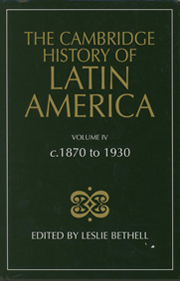Book contents
- Frontmatter
- 1 Latin America and the international economy, 1870–1914
- 2 Latin America and the international economy from the First World War to the World Depression
- 3 Latin America, The United States and the European powers, 1830–1930
- 4 The population of Latin America, 1850–1930
- 5 Rural Spanish America, 1870–1930
- 6 Plantation economies and societies in the Spanish Caribbean, 1860–1930
- 7 The growth of Latin American cities, 1870–1930
- 8 Industry in Latin America before 1930
- 9 The urban working class and early Latin American labour movements, 1880–1930
- 10 Political and social ideas in Latin America, 1870–1930
- 11 The literature, music and art of Latin America, 1870–1930
- 12 The Catholic Church in Latin America, 1830–1930
- Bibliographical essays
- Index
- References
2 - Latin America and the international economy from the First World War to the World Depression
Published online by Cambridge University Press: 28 March 2008
- Frontmatter
- 1 Latin America and the international economy, 1870–1914
- 2 Latin America and the international economy from the First World War to the World Depression
- 3 Latin America, The United States and the European powers, 1830–1930
- 4 The population of Latin America, 1850–1930
- 5 Rural Spanish America, 1870–1930
- 6 Plantation economies and societies in the Spanish Caribbean, 1860–1930
- 7 The growth of Latin American cities, 1870–1930
- 8 Industry in Latin America before 1930
- 9 The urban working class and early Latin American labour movements, 1880–1930
- 10 Political and social ideas in Latin America, 1870–1930
- 11 The literature, music and art of Latin America, 1870–1930
- 12 The Catholic Church in Latin America, 1830–1930
- Bibliographical essays
- Index
- References
Summary
The periodization of Latin American economic history around ‘external shocks’ has been increasingly rejected in recent years. Yet if we wish to explore – as an open question – the role of the international economy in the economic development of Latin America, the First World War and the World Depression enclose a significant period. It bridges the gap between the first major ‘external shock’ of the twentieth century and the final breakdown of the export-led growth mechanism of the ‘Golden Age’ whose starting point had been around 1870. The period also represents the key years in the changeover from one hegemony to another: Britain's decline as a major economic power was hastened by the war (when Germany was eliminated) and the United States was thrust into the role of Latin America's major investment and trade partner.
Nevertheless, generalizations about Latin America as a whole, dangerous at the best of times, are particularly difficult in such a period of transition. Change occurs at different rates in different countries and perceptions vary: in some countries the ‘Golden Age’ clearly continues until 1929; in others fundamental changes occur between 1914 and 1929 and the period is aptly characterized the ‘Great Delay’; and in others the roots of change were there well before 1914.
In this chapter we first describe the major characteristics of the changing world economy between the First World War and the World Depression. Then we explore the impact of these changes on the Latin American economies. The conclusion attempts an evaluation of the extent of change and the long-term significance of the period.
- Type
- Chapter
- Information
- The Cambridge History of Latin America , pp. 57 - 82Publisher: Cambridge University PressPrint publication year: 1986
References
- 3
- Cited by

